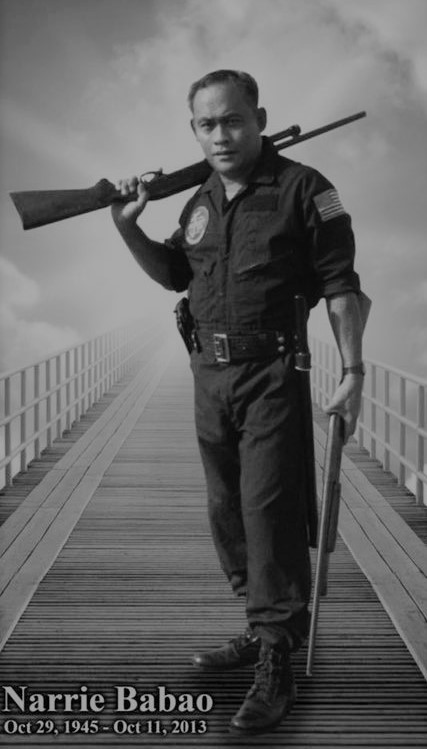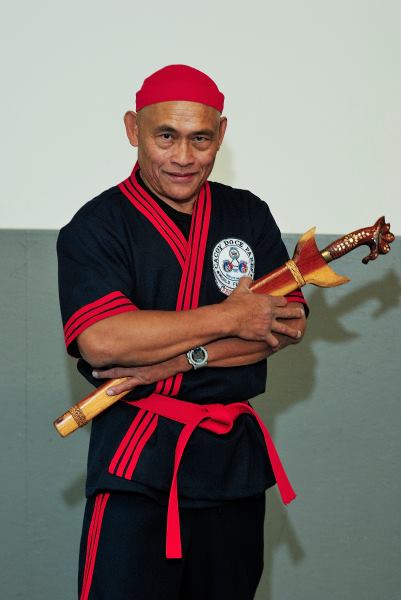A weapon based martial arts from the Philippines. It’s a full system that incorporates empty hands, kicking, blades, and various weapons. There are very few qualified and certified instructors that teach the Filipino Martial Arts (FMA). Besides learning self-defense, students will enhance their motor skills, develop better reflex, improve cardio, coordination, and concentration, and become healthier.
Eskrima (Arnis), is the only Filipino traditional martial art that comprises Espada Y Daga (sword & dagger) and Blade Techniques, is thought to be the most complete and all-encompassing type of fighting.
Eskrima is very effective and realistic. Come join us!
SGM Cacoy was a Filipino martial artist of the Doce Pares Eskrima Club. He was the last surviving member of the club, which was founded in January 1932. He was also a 12th degree black belt. His version of the Doce Pares Eskrima system is known as Cacoy Doce Pares. In 1951 he developed a personal system of his named Eskrido.
Honors
1979: March, Presidential Champion Trophy, 1st National Arnis Masters Open in Manila, Philippines
1979: August, Champion, 1st National Arnis Invitational in Manila, Philippines
1997: Inducted into Cebu City Sports Commission, Hall of Fame
1999: Appointed Sports Commissioner for Eskrima, Eskrido and Pangamot, by Mayor A. Garcia, Cebu City
2000: January, chosen as one of the “Most Outstanding Cebuanos of the Century” by the Cebuano Studies and Historical Association
2000: February, picked by the Cebu Historical Center as one of the “Four Outstanding Individual of Cebu City”
2000: July, Filipino Martial Arts Hall of Fame in El Paso, Texas, USA
2000: December, Blackbelt Hall of Fame (“Weapons Instructor of the Year”) in Los Angeles, California, USA
2003: July, US Martial Arts Association Hall of Fame (“Most Distinguished Grandmaster of the Year”) in St. Louis, Missouri
2003: July, World Martial Arts Hall of Fame in Columbus, Ohio
2004: July, US Martial Arts Association Hall of Fame (“Philippine Martial Arts Legend”) in St. Louis, Missouri
2005: February, Mayor Tomas Osmeña’s Special Awardee, Cebu City, Philippines
2005: June, World Martial Arts Masters Association Hall of Fame in Los Angeles, CA
2006: October, Martial Arts History of Museum Hall of Fame in Los Angeles, CA
2006: November, Cebu Eskrima Society Hall of Fame in Cebu City, Philippines
2008: March, Doce Pares Hall of Fame (“Doce Pares Legend”) in Cebu City, Philippines
2008: May, International Martial Arts Times Magazine Hall of Fame (“Supreme GM of the Year”) in Pakistan
Authored books
1988: Basic Doce Pares Eskrima
2002: Pangamot (Bare-handed Defense System)
2004: Eskrido (Eskrima, Jujitsu & Judo Integrated)
2009: Eskrima-Arnis Techniques
2014: Olisi-Baraw


One of the 5 aspects of combat is weapons training. When training in street effective combat arts. Weapons training is an important aspect that should not be ignored.
The results can be amazing when the speed and power gained from Taekwondo are applied in a self-defense scenario against the weak points of an attacker's body. Women can emphasize many of their inherent physical attributes in taekwondo while learning a technique for self-defense that is effective against a much larger opponent.
For many people, this is not something that comes naturally, but self-confidence may be built over time. Your confidence grows as you achieve new goals via taekwondo. The discipline and self-assurance you learn in taekwondo may be applied to all facets of your life.


In November 1963, 18 year-old Narciso “Narrie” Requina Babao reluctantly started his Arnis de Mano training under his father, the late Turing Babao. The style he learned was the Baston Batangas system, which his father learned from Master Ka Juan, a Katipunan rebel under General Miguel Malvar, during the FilipinoAmerican war. Turing Babao was suffering from hypertension, and his doctor advised him to workout daily, to alleviate the problem. Narrie had other interests then. Foremost was bodybuilding and weightlifting. He was selected as the 1964 Jr. Mr. Philippines, during a contest sponsored by PWABBA (Philippine Weightlifting and Bodybuilding Association). For two years, the father and son trained hard in Arnis. Twirling the rattan sticks was the only warm-up exercise. Their training consisted mainly of free-style sparring. Only after getting hit, would Narrie learn the lesson for the day. His father would then methodically explain why Narrie got hit in that particular area.
Narrie described the training as the school of hard knocks, and he resented being on the receiving end. His father was precise in controlling his strikes to the head and body, but accidental hits to the knuckles were unavoidable. With his knuckles busted many times over, Narrie finally found a good excuse for getting away from Arnis training. He enrolled in a karate school. His Shotokan karate instructor was Romeo Plantado, a former police officer who became a fugitive, and eventually a commander of the New People’s Army, the communist rebels in the Philippines.
However, it was Master Jimmy Galez of Manila, who awarded Narrie his first black belt. The first thing Narrie did after his promotion in Manila, was to challenge his father in a weaponless sparring. Narrie realized his mistake too late. His father never revealed the fact that he also studied Jujitsu from a Japanese businessman, whom he befriended. In 1968, Narrie joined the United States Navy.
His first students were some of the sailors and Marines on board the USS New Orleans (LPH-11), which spent three tours of duty in Vietnam. At one time, one of his Marine students came back to the ship in a body bag after a mission. Whenever his ship was in Subic Bay, Narrie would spend time at the school of the Philippine Kuntaw Association, which was owned by Grandmaster Carlito Lanada. In time, Narrie was awarded a fourth degree black belt in Kuntao.
In July 1978, Narrie became the first Weapons Sparring champion, during a tournament sponsored by Ben Singleton in Vista, California. It was the first of its kind in American martial arts competition, where the fighters would select the weapon of their choice.
Like the three sides of the triangle, the Babao Arnis system is composed of three main fighting systems; Villabrille-Largusa Kali, Cacoy Doce Pares, and the original Baston Batangas taught by Turing Babao. (Babao Arnis, 2005). From 1978 to the present time (2013), Grandmaster Narrie Babao has only promoted to the rank of Arnis instructors, 3 Masters and 18 Guros.
Most of his students were already black belt instructors in other martial arts, when they applied for Arnis training. Many of his students are involved in law enforcement. (Babao Arnis, 2013).
REST IN PEACE WITH THE LORD, NARRIE BABAO GM Narrie Babao passed away on Friday, October 11, 2013, around 3:00 p.m. in the afternoon, at the ICU at Balboa Naval Hospital San Diego. He had a stroke followed by heart attack.
© 2023 P.A.M.A. | All Rights Reserved